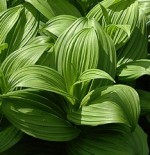 False hellebore is a herbaceous perennial and a member of the Melanthiaceae family that also includes Trillium. It is native to eastern and western North America and grows in wet woods and swamps from Canada to the Carolinas but is also found in Alaska, and the mountains of Idaho, Oregon, and Washington. False hellebore is not even vaguely related to the other plants more commonly known as hellebores that include Christmas hellebore, Lenten rose, and stinking hellebore. False hellebore is is a tall unbranched plant with a thick rootstock and a leafy, hairy stem bearing light green foliage. The leaves are oval, up to 12″ long, and have hairy undersides. The small greenish white to greenish yellow flowers are hairy and borne in dense branching terminal panicles up to 12″ long. They appear in summer and give way to capsules that are straw-colored to dark brown.
False hellebore is a herbaceous perennial and a member of the Melanthiaceae family that also includes Trillium. It is native to eastern and western North America and grows in wet woods and swamps from Canada to the Carolinas but is also found in Alaska, and the mountains of Idaho, Oregon, and Washington. False hellebore is not even vaguely related to the other plants more commonly known as hellebores that include Christmas hellebore, Lenten rose, and stinking hellebore. False hellebore is is a tall unbranched plant with a thick rootstock and a leafy, hairy stem bearing light green foliage. The leaves are oval, up to 12″ long, and have hairy undersides. The small greenish white to greenish yellow flowers are hairy and borne in dense branching terminal panicles up to 12″ long. They appear in summer and give way to capsules that are straw-colored to dark brown.
Warning: Also known as American hellebore, this North American native is extremely toxic and should not be used as a home remedy. There are medicinal benefits to the plant but they are limited because of its toxicity. The herb contains some ester alkaloids that are used to treat hypertensive toxemia during pregnancy and some dire cases of pulmonary edema but this is not an herb for experimentation.
Type: Perennial herb
Bloom: Greenish yellow flowers one inch wide are borne on panicles up to two feet wide in summer.
Foliage: Alternate, bright green, oval or elliptical leaves are 6-1” long and 3-6” wide, and are hairy and heavily ribbed.
Size: 2-8’ H x 2′ W
Light: Light shade
Soil: Average, moist
Hardiness: Zones 3-8
Care: Low maintenance
Pests and Diseases: None of significance
Propagation: Division; seed.
